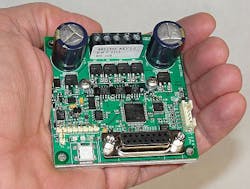Intelligent motor controller for robots and industrial automation introduced by RoboteQ
SCOTTSDALE, Ariz., 7 April 2013. RoboteQ Inc. in Scottsdale, Ariz., is introducing introduces the SBL1360 intelligent motor controller for mobile robots, industrial automation, mechatronics, or other medium-power motor-control applications.
The SBL1360 can drive a hall-sensor-equipped brushless DC motor to 30 Amps and 60 volts, and accepts commands from either analog pedal/joystick, standard R/C radio, USB, CAN, or RS232 interface.
Using the serial port, the controller can connect robots to single-board computers, wireless modems, or WiFi adapters. Using CAN bus, as many as 127 controllers can be networked on one twisted-pair network.
The SBL1360 has a basic language interpreter that can execute more than 50,000 Basic instructions per second. This have can be used to write scripts for add custom functions, or for developing automated systems without the need for an external PLC or microcomputer.
The SBL1360 uses the motor's hall sensors to measure speed and travelled distance. The controller can operate the motors in open loop or in closed loop speed or position mode with a 1 kHz update rate. The SBL1360 has intelligent current sensing that will limit the power output automatically to 30 amps in all load conditions. The controller also includes protection against overheat, stall, and short circuits.
The controller includes as many as four analog, six digital and five pulse inputs. Two 1.5-amp digital outputs are provided for activating brakes or other accessories. The controller's operation can be optimized using nearly 80 configurable parameters, such as programmable acceleration or deceleration, amps limits, operating voltage range, and use of I/O.
A PC utility is available for configuring, tuning and exercising the motor. The controller can be reprogrammed in the field. The SBL1360 comes on a 7-by-70-millimeter board with an aluminum bottom plate to dissipate heat without a fan.
Designers can get additional cooling by mounting the board and its bottom plate against a metal chassis. For more information contact RoboteQ online at www.roboteq.com.

